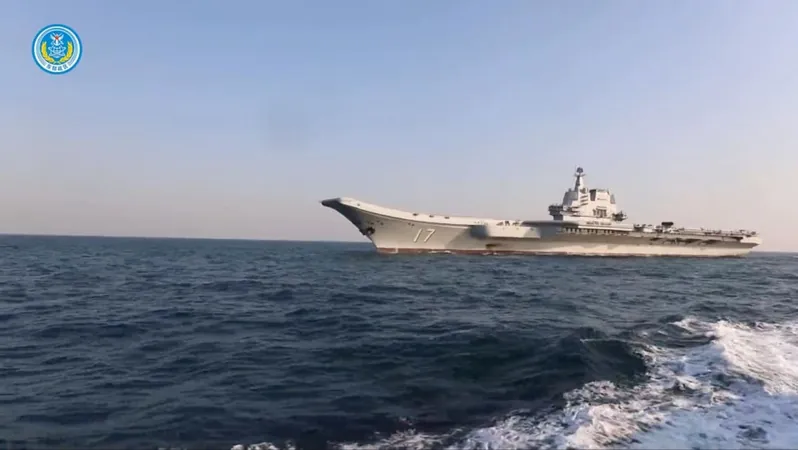
China's "Strait Thunder-2025A": A Bold Show of Force in the Taiwan Strait Amid Trump’s Return
2025-04-05
Author: Ming
China's Military Maneuvers and Their Significance
In a significant demonstration of military might, China’s People’s Liberation Army (PLA) has deployed the aircraft carrier Shandong along with a formidable fleet of 19 warships for military exercises encircling Taiwan. This operation, which has been officially named 'Strait Thunder-2025A,' marks a notable shift in China's military posture, breaking from their previous practice of naming exercises only after completion. The drills feature live-fire exercises and simulated blockade operations, underscoring the growing tensions between China and Taiwan against a backdrop of deteriorating relations.
Taiwanese Vice President Lai Ching-te recently escalated the rhetoric by labeling China as a 'foreign hostile force' and announcing plans to reinstate Taiwan’s peacetime military court system. This move highlights the increasingly precarious situation across the Taiwan Strait.
Timing and Historical Context
The timing of these exercises is particularly critical, coinciding with the anniversary of the 1979 Taiwan Relations Act—an important U.S. policy that has historically supported Taiwan’s defense capabilities. These drills are not merely military exercises; rather, they are part of China's long-term strategy related to Taiwan, which Beijing views as an integral part of its territory.
A Shift in Military Strategy
Interestingly, the PLA has adopted a new approach in presenting these military activities. Unlike previous exercises that were framed as responses to specific provocations, the codename 'Strait Thunder-2025A' indicates a shift toward a more systematic and ongoing military strategy. This evolution suggests that rather than escalate in direct response to provocations, the operations around Taiwan are becoming routine, a tactic aimed at normalizing China's military presence in the region.
Psychological Strategies and Messaging
A key aspect of these drills involved the PLA Eastern Theatre Command releasing four military action posters that convey a strategy of psychological intimidation. These themes encompass various strategies including 'advancement,' 'deterrence-containment,' and 'destruction-paralysis.' Such messaging serves to reshape international expectations about military activity in contested spaces, allowing China to apply pressure without triggering a significant crisis.
Historical Comparisons and Ongoing Operations
Historically, military drills in the Taiwan Strait have revolved around high-stakes, episodic crises. The comparison to the 1995-1996 Taiwan Strait Crisis is poignant; back then, exercises were clearly marked as exceptional emergencies. In contrast, China's current military posture represents a more integrated and ongoing strategy, blurring the lines between routine operations and exceptional military actions.
Enhancing Territorial Control
Recent operations have demonstrated capabilities not only for direct military engagement but also for enforcing territorial claims through maritime control and 'law enforcement patrols.' The inclusion of coast guard vessels in military exercises illustrates a strategic shift towards considering these waters as 'internal seas' of China, thereby militarizing civilian agency to fortify territorial assertions.
Context of U.S.-China Relations
The Chinese military’s activities in the Pacific region have surged since early 2023, indicating a notable transformation towards persistent maritime presence rather than sporadic engagements. As these developments unfold, the return of Donald Trump to the White House adds a layer of complexity in U.S.-China relations. Trump's foreign policy, characterized by a transactional approach to international relations, may lead to a re-evaluation of America's strategic ambiguity regarding Taiwan.
Conclusion and Future Implications
The PLA’s recent exercises could symbolize a calculated emergence of Chinese probing into the new administration's stance towards Taiwan. As Beijing tests the political waters, the nomenclature and magnitude of military actions signal an intention to gauge Trump's response—balancing tactical endeavors while navigating ideological confrontations that the region has long faced.
As the dynamics in the Taiwan Strait intensify, the international community watches closely, aware that the stakes might not only affect regional stability but also result in a recalibration of global power balances. Stay tuned as this story develops—it could signify not just a military challenge, but a pivotal point in U.S.-China relations that resonates far beyond Asia.


 Brasil (PT)
Brasil (PT)
 Canada (EN)
Canada (EN)
 Chile (ES)
Chile (ES)
 Česko (CS)
Česko (CS)
 대한민국 (KO)
대한민국 (KO)
 España (ES)
España (ES)
 France (FR)
France (FR)
 Hong Kong (EN)
Hong Kong (EN)
 Italia (IT)
Italia (IT)
 日本 (JA)
日本 (JA)
 Magyarország (HU)
Magyarország (HU)
 Norge (NO)
Norge (NO)
 Polska (PL)
Polska (PL)
 Schweiz (DE)
Schweiz (DE)
 Singapore (EN)
Singapore (EN)
 Sverige (SV)
Sverige (SV)
 Suomi (FI)
Suomi (FI)
 Türkiye (TR)
Türkiye (TR)
 الإمارات العربية المتحدة (AR)
الإمارات العربية المتحدة (AR)